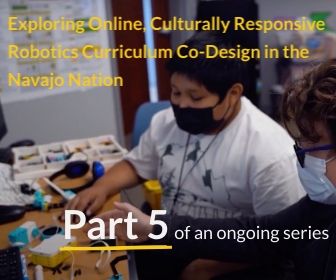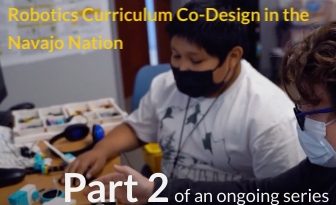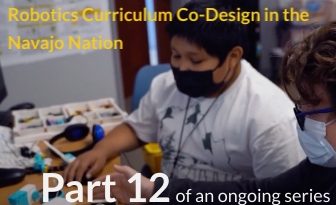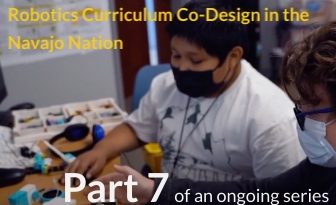Part 5: First Encounters (April and May 2021)
This is part of a series that chronicles the ongoing collaboration between Tufts CEEO and Little Singer Community School in the Navajo Nation. Click here to view the whole series.
TL;DR: The first six weeks of collaborating with Tom and his students were open for experimentation, and our plans changed a lot as we learned and adapted to the situation. By the end of the school year, we’d developed some protocols and methods that worked well, while others still needed further exploration.
I jumped into this project with Tom with very little notice, and when I (virtually) arrived in Tom’s 6th grade class, we had six weeks until the end of their school year. As I mentioned before, we were also working with Bill Church from WMSI, who is a good friend of the CEEO’s and was very interested in collaborating with us specifically on designing physics experiments/explorations with the SPIKE Prime kits that we’d shipped to Little Singer. With our combined superpowers and boundless enthusiasm, we immediately started working with Tom’s class four days a week to see just what we could do with the given materials and conditions to develop some cool, hands-on engineering projects that heavily overlapped with Tom’s current science and math lessons.
At our first meeting amongst the three of us, we originally proposed a method of swapping weeks, where I would do a week of basic engineering challenges to build basic skills with the SPIKE kits and coding app, and Bill would do a week of running an extended project where they’d build something and then use what they built to conduct some simple physics experiments. Like most hastily made first round plans, this gave way quickly to a better model that was more realistic for our work schedules. Bill still had his full time job at WMSI, while I was poised to invest a significant chunk of time into this endeavor, so Bill became more of a “special guest” instructor who would pop in for a few days at a time when he had a new project to share with us. Bill also contributed asynchronously by making completely amazing videos around his home and workspace to help illustrate the physics concepts we were working with and focus on the storytelling aspect of scientific investigations. His focus on wondering about and exploring everyday experiences with the physical world became a major theme of our work for the next six weeks.
I attended class every day (except Wednesdays, which were an early release day for the school) with Tom and his students and I also brought along two teaching assistants. These TAs were paid undergraduate Tufts students (mostly various engineering majors) who were interested in the project and in working with students. With such a small class size, our teacher to student ratio was sometimes 1:1, and it was great! Of course most teachers never get this kind of support either in person or for online instruction and many would think this is an overindulgent luxury. But with all of the technical challenges we faced (check out Part 3 of the blog series) our high teacher/student ratio was absolutely necessary. Between dropped zoom calls, difficulties hearing and seeing, and basic challenges beginners always face with a new robotics kit, we very frequently had students working with an instructor one-on-one in a breakout room to help get caught up. We would not have been able to make the progress that we did during that time without this ability, and the one-on-one breakout room sessions became our most commonly used and surefire method for helping students stay on track and participate to the fullest extent.
We had the same group of TAs visiting week after week, and it wasn’t too long before we really started to feel a sense of building an online community with Tom and his students. As is usually the case with a group of students, the more time we spent with them, the more they opened up and were responsive to us in asking questions, providing answers and ideas, and generally getting along.For me, it was a delight to get to know the kids I was working with, and to build a rapport with them daily instead of just popping in every once in a while. The tradeoff of course is that I dedicated a huge number of my weekly work hours to this project, which is rarely ever an option for folks providing support like this. It was fun and great for me, but I also worried that the model of support we were engaging in was too time-intensive to be easily replicable for other projects in Tech and Play. This is something I’m still struggling with, because I really do believe that in order to provide teacher support that is authentically useful and gives lasting results, you gotta put in the real hours with that teacher and their class.
Another rookie mistake I made early on was related to my previous experience teaching SPIKE Prime robotics online. I had gotten used to doing online workshops with groups of students who self-selected into said workshops, had really excellent internet connections and plenty of workspace, probably had lots of previous experience with LEGO robotics, and also had plenty of free time to keep building and finishing up the challenges I gave them after my 90 minute session with them had come to a close. I had it so easy, that I’d lost track of how much work it takes to really get into the groove of doing building and design projects with kids. Now, I was working for only a 60 minute session, and we had many more things to cover that ended up taking far more time than I anticipated. But that’s OK of course, that’s where having the flexibility to adapt our schedule came in handy. We’d originally planned to do a different building project each day of the week, so I made plans a few weeks in advance and filled each day with a new activity. The nice thing was, I was mostly pulling from activities I’d already done and had documented, so it wasn’t too much work. But after the first week, we realized that we’d need to take things more slowly — which was also fine because it meant I wasn’t in a huge rush to develop and prep more projects.
Speaking of scheduling projects, the logistics of running these sessions were also thrown together pretty quickly, but it worked. In order to keep all the TAs, Bill, Tom, and myself all on the same page, I created a simple Google Doc that kept track of all the important information and a daily/weekly summary of what we were doing. At the top of the page, I had the weekly TA schedule, zoom link, and a short list of projects I hadn’t scheduled yet but wanted to keep reminding myself about in case we had time to do them. Thankfully, the majority of these projects already had documentation (either full slide decks of lessons, placemat instructions, or both) so I could simply hyperlink to the other resources. I organized our activities by Week, and the weeks into the four days. We pre-populated the days with what we intended to do, and then after each class I’d go back and revise it to document what we actually accomplished and what we intended to do the next day. This was a huge help with dealing with the huge incongruities between how long we thought a project would take and how long it actually took. As the weeks went on, we kept adding to the document and greying out the previous weeks so that it was visually easy to scroll down to find where we were currently. This simple document was a huge help, and now it’s a great resource to reflect on what we did.
Overall, we were satisfied with the projects we did with the students, but we hadn’t yet perfecting anything. It was great to have this sort of play time where we were free to experiment with what we were doing and how we’d do it. We learned a lot about how to handle the practical side of running these sessions (like utilizing one-on-one breakout sessions, and providing lesson material ahead of time so if kids missed part of the zoom call, they still knew what was going on) as well as the curriculum development side of things (making more time for projects, and developing online hubs where students could document their work). Speaking of student work documentation, I’ll be talking more about that soon because it’s perhaps one of our biggest challenges in working with the students. Getting students to document their work, thought processes, and project results is a perennial challenge in engineering classes even under the best of circumstances.
The really cool part was that all of this work was immediately applicable to the NEXT big thing: summer enrichment! Tom and his students only had a couple days off after the last day of school before a four week (the month of June) summer enrichment program started, and we used what we learned to jump immediately into developing a robotics curriculum for it. There was barely time to stop and reflect before diving into the new session, but we did make some interesting changes and revisions to our approaches, and I’ll be discussing those in the next blog post.




